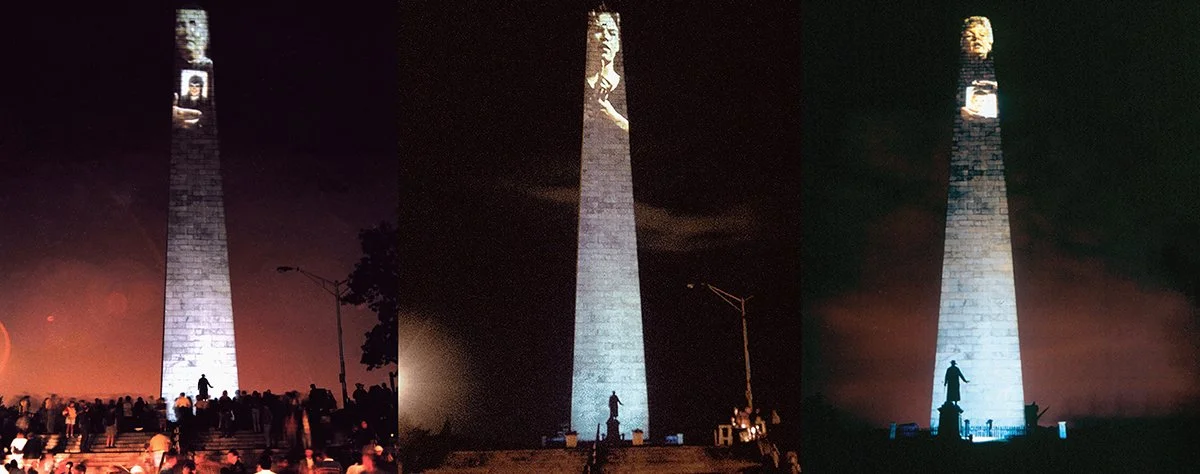When Juan Obando intervenes in Dock Square this month with "Summer Sets," he joins a rich tradition of artists who have interceded in public space to create conversation and spark change. With a large-scale rendering of the area around the Samuel Adams monument with everything but the statue, Summer Sets will ask a very straightforward question “What past, present, and future is being constructed in our city?” Artistic interventions into monuments are as old as most monuments themselves, which is to say about 150 years old. Many of Boston’s monuments, including Anne Whitney’s Samuel Adams, were erected in the late 19th century as part of the so-called “City Beautiful” movement; these monuments were meant to unify Bostonians around particular historical narratives and create places for community. But what makes a city beautiful? Is it the narratives that hold us together? The routines we build to fuel our lives? The parks, shops, schools, and public spaces where we gather? What structures truly make a city and its people?
From poetic performances to politically motivated oration, artists use monuments as fertile ground for inquiry, debate, and conversation. As we present a stage to contemplate our collective, under-construction future, we look back at some genre-defining monument interventions. This is a short list: if you have a favorite monument intervention, we’d love to hear from you!
Krzysztof Wodiczko’s Bunker Hill Projection: One of the artist’s first projections, this work featured video interviews with Charlestown mothers impacted by gang violence., the videos were projected to the top of the Bunker Hill Monument, thus casting the mothers’ image and testimony for all of the neighborhood to see. Bunker Hill Projection is an early example of what we now call “social practice,” in which artists include community stakeholders in the active conversation and collaboration. Over summer 1998, Wodiczko spoke with family members who lost their loved ones to murder and violence in Charlestown, later compiling them into the thirty-minute projection. By placing them amidst a monument memorializing the Revolutionary War battle, Wodiczko contextualized their stories within the prevailing historical narrative while also questioning the role of violence in shaping the neighborhood. Wodiczko’s “projections”projects are ongoing.
Krzysztof Wodiczko’s Bunker Hill Projection via Harvard Graduate School of Design
Iván Argote's Turistas: A contemporary of Obando's, Argote has long used monuments of their native Colombia as both a material and subject. In the photograph series Turistas, he depicts historical bronze statues celebrating Spanish colonizers wearing traditional ponchos. The series includes monuments from North and South America, highlighting the reach of figures such as Christopher Columbus. More recently, his show "A Place For Us," on view last summer at Perrotin, New York. This installation included fragments of taken-down monuments with green plants sprouting from them, suggesting what futures might come in their stead.
Karyn Olivier's The Battle is Joined: Part of Monument Lab's 2017 exhibition of artists intervening with monuments to offer new perspectives on them, this work completely covered Philadelphia's Battle of Germantown Memorial with mirrored acrylic. Instead of facing the memorial, Olivier's work allowed viewers to face themselves. Hiding the memorial behind this reflection of the present, this intervention demonstrated how we can make public space. As Olivier explained the work, "We will be reminded that this memorial can be an instrument and we, too, are instruments—the keepers and protectors of the monument, and in that role, sometimes we become the very monument itself."
From Iván Argote’s A Place for Us (2021) via Perrotin
Karyn Olivier’s The Battle Is Joined, via Monument Lab
Joiri Minaya's The Cloaking: Like a neat blend of Argote and Olivier's work, Minaya's The Cloaking completely covered two colonialist-aggrandizing monuments in Miami. Minaya used colorful "tropical" patterns to amplify the ways in which the Caribbean has been exoticized, with its natural wonders monetized and capitalized on. While Minaya creates these patterns, she often depicts plant life from the Caribbean. These works, therefore, envelop the statue in the nature destroyed by colonialist in their exploitation of the land.
Have you seen one of these? Or other similar monument interventions in your neighborhood? Let us know on social media with #SummerSetsBOS. We invite you to join our conversation starting July 18 in Dock Square with “Summer Sets.”
Here’s a short list of recent (since 2015) resources into this layered history and how artists continue to use monuments as a subject and material to probe, disrupt and spark imagination
Art Papers Summer 2020 issue
All Monuments Must Fall syllabus
Erin Genia monuments in perspective
“Twilight of the Idols,” City Journal
N+T Asks series on monuments presented with Goethe-Institut Boston
Header photo: Summer Sets rendering provided by artist Juan Obando (c)




